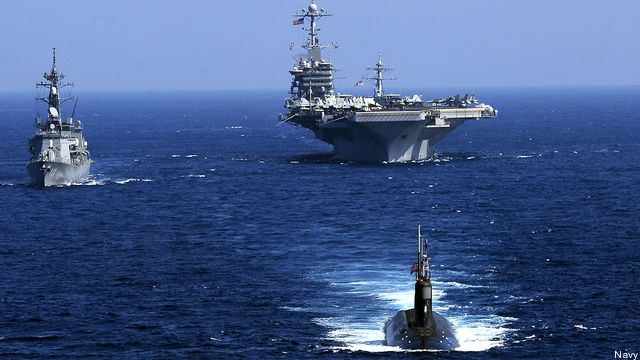Navy Budget Share Grows, Boosted By Pacific Strategy Shift
Posted on
 PENTAGON: The Navy would get the largest budget share among the three military services in the 2014 budget submitted Wednesday, but would still see a drop in total funding from what Congress provided for this year in the final version of the continuing resolution.
PENTAGON: The Navy would get the largest budget share among the three military services in the 2014 budget submitted Wednesday, but would still see a drop in total funding from what Congress provided for this year in the final version of the continuing resolution.
The $155.8 billion requested for the Navy Department in the president’s proposed defense budget of $526.6 billion is level with the president’s 2013 request but is $11.4 billion above the request for the Air Force and $26.1 billion larger than that for the Army.
The request, however, is $4.1 billion below its current funding, mainly because the budget did not include Overseas Contingency Operations (OCO) funds, which provided $14 billion for Navy and Marine operations connected with the conflict in Afghanistan.
Pentagon officials said the OCO request was delayed because President Barack Obama has not decided on how many U.S. troops will remain in Afghanistan after the planned cut of 34,000 this year. The Navy will get about $14 billion in OCO funds this fiscal year.
The Navy’s increased share of the total defense budget is a reflection of the focus on supporting the new strategic guidance that calls for a rebalancing of forces to the Asia-Pacific region, with its vast ocean areas.
The total defense budget request, however, is about $51 billion higher than allowed under the spending caps set by the 2011 Budget Control Act, creating the threat of another bout of the painful sequestration that had made the current budget year so difficult.
Rear Adm. Joseph Mulloy, the Navy’s budget chief, said he will have to send Congress a number of requests to reprogram funds provided in the final CR to cover shortfalls in operations and maintenance, as well as some major ship construction programs for the remainder of the 2013 fiscal year.
The new budget request “2014 will be a tight year,” Mulloy said, and the future years’ budget proposals would provide no growth after inflation.
The Navy would get $45 billion for personnel, a slight increase over the current year. The Navy itself would add only about 900 sailors and the Marine Corps would continue its cuts in personnel of about 5,000 a year heading to a project total force of 182,100. The Marine budget is included in the Navy’s.
The $49 billion requested for operations and maintenance is about $1 billion less than the current year and would force the Navy and Marines to continue the cutbacks in training, depot maintenance and deployments not responding to demands from the regional combatant commanders, Mulloy said.
Procurement also would drop by about $1 billion to $62 billion, but would protect most of the department’s major acquisition programs. The Navy would buy eight new ships, down from 11 this year. It would continue to get two Virginia class attack submarines and four Littoral Combat Ships on multi-year contracts, but would buy only one DDG-51 and one Mobile Landing Platform, which will be modified to serve as an Afloat Forward Staging Base.
The proposed budget would buy no additional F/A-18 strike fighters — down from the 37 Congress funded this year — but would purchase 21 EF-18Gs, the electronic warfare version of the Boeing-built jets. The budget would sustain the F-35 program at the current level, buying six of the short take off, vertical landing versions for the Marines and four carrier variants for the Navy. It also would provide five E-2D radar warning planes and 16 P-8 patrol jets, 29 T-6A training planes and one UC-12 utility aircraft for the Navy and two KC-130J refueling transports for the Marines.
The aviation account also would receive money to buy 25 AH-1Z and UH-1Y helicopters, a drop of six, and 18 MV-22 tilt-rotor transports for the Marines. The Navy would get 37 MH-60 helicopters, the same as the current year. The Navy would get only one more MQ-8 Fire Bird unmanned aircraft, down for six this year, because the ships that would carry them have not been built, Mulloy said.
For ground equipment, the Marines continue a slow increase in their trucks and support systems, but are still a year away from buy the first of the Joint Light Tactical Vehicles to replace the aged Humvees.
The biggest change in the research and development account is an increase in funds to $1.08 billion.for designing the SSBN-X, the replacement for the Ohio class ballistic missile submarines R&D for the F-35 would drop by about $400 million to just over $1 billion.
Subscribe to our newsletter
Promotions, new products and sales. Directly to your inbox.
